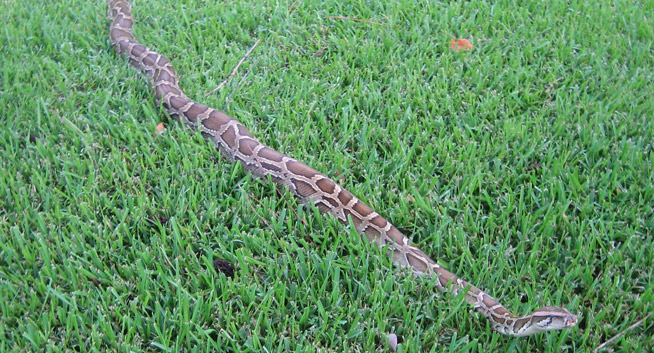
Burmese Python in Florida:
Burmese Pythons, indigenous to southeast Asia, have established thriving and breeding populations in southern Florida, where the climate meets the conditions necessary for this snake's survival. This has caused a big ruckus in the media, because
people are naturally fascinated by large snakes, often because of fear, hopes in monsters, etc. We all want to believe in monsters, like sharks, big scary sharks. Of course, education reveals time and again that all of our large predators
are relatively rare, and highly persecuted by the earth's top killer, humans. Same for the Burmese Pythons in FL. Yeah, I know, they are not native. But they're also not causing any real problems. It's never the big creatures that cause real
widespread damage - it's the small ones. Think mosquitoes, ticks, pine beetles, etc. Anyway, below is some Burmese Python info.
If you do come across a Burmese Python in Florida, please report it to the Florida Wildlife Commission hotline: 1-888-IVE-GOT1 or they can be reported on EDDMapS: www.eddmaps.org/florida/report/
Biology:
The Burmese python, scientifically known by the name, Python molurus bivittatus, is one of the most feared of all snakes, primarily due to the size. How big do snakes get? The Burmese python is an endangered species in their native country, and they are hunted there by poachers for their skins. They are also prized by many Americans as pets. The average python is very large, with the largest coming in a little over 18 feet long and weighing as much as 200 pounds. The Burmese python is among one of the largest breeds of snakes anywhere. The average python is known to have shades of light brown skin with red and black markings although many different snake breeders have created Burmese pythons that are different from the normal markings and in some cases, ones that are albino.
Habitat:
Although native to parts of Southeast Asia and China, the Burmese python has found its way to the humid somewhat tropical conditions of southern Florida. Many, if not most of these reptiles have found themselves sharing space together in the Everglades. However, most of them did not make it there by choice. Burmese pythons are a species that many people felt would make interesting and exotic pets. However, since the average length and weight of one of these snakes make it difficult for homeowners to house them, some Burmese have been let free of their cages and dumped out in the Everglades to fend for themselves. Still others have been lost and found their way to reside with the different kinds of exotic animals in south Florida. It is also believed that when several destructive hurricanes stuck Florida that some of these snakes escaped from local pet stores never to be caught.
Burmese pythons can climb up into trees where they can drop down, if they choose to, on their prey or hang out under water for up to 30 minutes at a time. Just as the climate of Florida makes it a great breeding ground, the variety of available food does also. Burmese pythons value small animals such as rodents, rabbits, moles and so forth. There happens to be plenty of food in south Florida.
Behavior:
Burmese pythons are not shy animals. Although they normally eat rats and other small animals, it would appear that many of these snakes go after far bigger prey as they grow. The python loves to curl up under bushes during the daylight hours and will take cover during the winter months in tree trunks, in rocky openings and other sheltered areas. The amount of pythons have increased over the past couple of decades and many homeowners report seeing these snakes in their front or back yards, miles and miles from the glades.
Burmese pythons are not poisonous snakes, however they are constrictors, coiling around their prey and squeezing the life out of it. The officials in the state of Florida are extremely concerned about the invasion of these large snakes and their ability to take over most of the Everglades. The snakes do not seem to fear humans, and their strength and ability to kill, make it a danger to humans.
Diet:
When these snakes are small, they usually feed on mice and small rats. However, as they grown their appetites increase and they have to be fed more often. Although it can take some time to digest any large prey, these snakes are opportunistic and will attack their prey, even if they are not particularly hungry. Burmese pythons go after larger prey such as alligators and deer when they get in their way in the glades. Because they are able to sink their fangs into their prey and wrap their bodies around, killing their prey by constriction, they are seen as a threat to small children, especially in light of their lack of shyness around humans.
Reproductive:
It takes about five to seven years for the average python to become sexually mature. Snakes mate in the spring and the female can lay up to 100 eggs; however, the average number is about 30. The female will stay with her eggs, which is not normal with other snake species. The female will coil around her eggs, keeping them in a warm temperature until they hatch about two months later. After hatching the infant snakes are about a foot or so long and are on their own.
Below are some other species of snake that may look like a Burmese Python:
Red Tailed Boa
Many people want to know how to kill a Burmese Python, but you don't need to. The
best way to get rid of Burmese Pythons is to simply leave them alone. You can also
use a Burmese Python trap to catch them - that's one of the best ways for how to
remove Burmese Python. For more information, go to my
Snake Removal - How to Get Rid of Snakes home page.